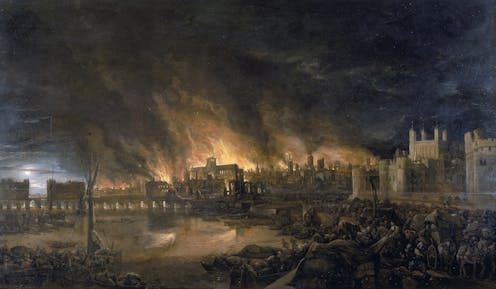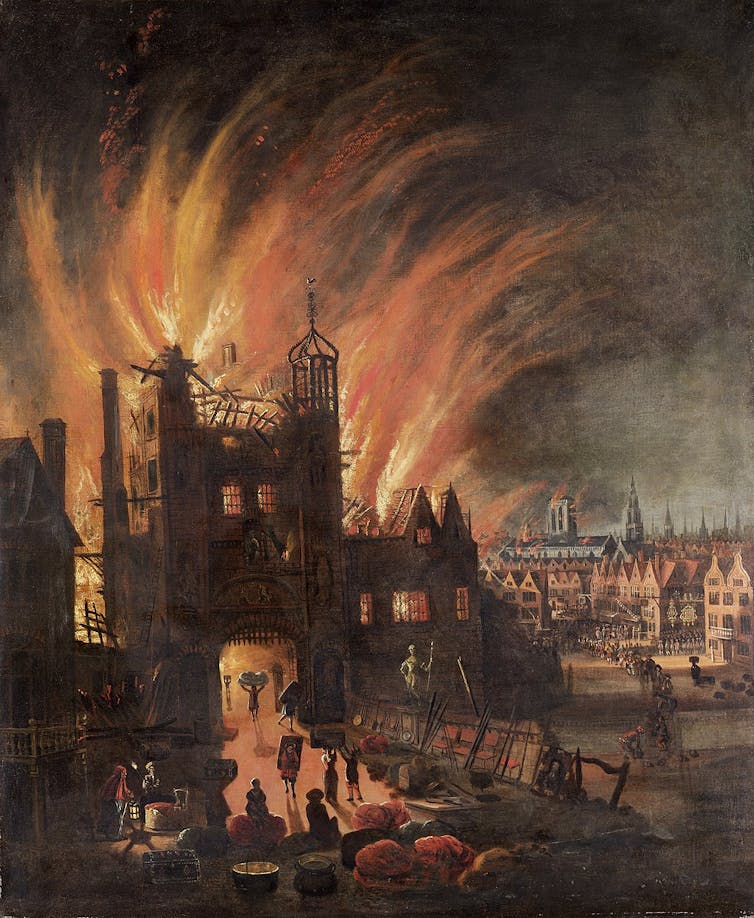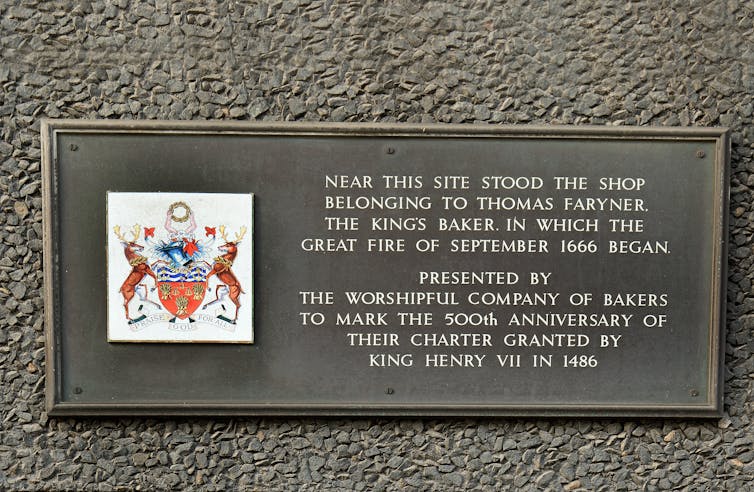
If you had been in London on September 2 1666, the chances are you’d remember exactly where you were and who you were with. This was the day the Great Fire began, sweeping across the city for almost five days.
The Museum of London is due to open a new site in 2026. And in preparation for this, curators of the Great Fire gallery decided to examine the stories of everyday Londoners.
As I’d been working with the museum on a project about teaching the Great Fire in schools, I was asked by Meriel Jeater, curator of the Great Fire displays, if I could help research the lives of these Londoners. Top of our list for investigation were the residents of Thomas Farriner’s bakery in Pudding Lane, where the fire began.
There has been lots of excellent work on the Great Fire but, because of ambiguities in the surviving sources, historians have different conclusions about who was in the bakery. Farriner, his wife, children and anonymous servants were among the people mentioned in modern accounts. But it was quickly clear I needed to go back to the manuscript evidence to find answers.
Two types of official investigation into the fire’s causes were carried out in 1666: a parliamentary enquiry and the trial of Robert Hubert, a Frenchman who had falsely confessed to starting the blaze. While you might think Londoners would have a keen interest in who was there at the start of the fire, the surviving accounts of exactly who was present are fragmentary.
Full reports from the enquiries were not published. Meanwhile, most writers at the time were, understandably, much more concerned with the fire’s destructive power than describing its beginnings.
As a result, the clearest account of events in the bakery is in a letter from an MP, Sir Edward Harley, reporting what he had heard. It’s now in the British Library, and was written in October 1666, when the two investigations into the fire were underway:
The Baker of Pudding Lane in whose hous ye Fire began, makes it evident that no Fire was left in his Oven … that his daughter was in ye Bakehous at 12 of ye clock, that between one and two His man was waked with ye choak of ye Smoke, the fire begun remote from ye chimney and Oven, His mayd was burnt in ye Hous not adventuring to Escape as He, his daughter who was much scorched, and his man did out of ye Windore [window] and Gutter.
Narrowing down the suspects
Other details in Harley’s letter suggested he was reliably reporting what he’d learned. The letter provides a list of bakery residents: Thomas Farriner, his unmarried daughter (Hanna), his “man” (meaning trained workman, aka journeyman) and his maid, who died. Other reports don’t mention the “man” or maid, but put Farriner’s son in the bakery.
A document in the London Metropolitan Archives provided more clues. This records the charges against Robert Hubert and – crucially – the names of seven witnesses against him. At the end were: “Thomas Farriner senior, Hanna Farriner, Thomas Dagger, Thomas Farriner Junior”.

Given that Thomas Dagger was sandwiched between the Farriners, Jeater and I suspected that he might be an unrecognised member of the household. Testing this theory, I was able to establish that the indictment’s list of names began with two men who had heard Hubert’s confession and a third who possibly had. The later names, starting with Thomas senior, appeared to be people who could testify to circumstances in the bakery.
This was exciting, because Thomas Dagger looked like a candidate for Farriner’s “man” in Harley’s account, potentially putting a name to the first reported witness of the Great Fire. Searching online archives, I could see there was a baker named Thomas Dagger running a business in Billingsgate after the fire and having many children. But we needed evidence to put Dagger in Pudding Lane.
Sleuthing in the archives
Fortunately, the Bakers’ Company records had not gone up in smoke like so many other guild documents did in September 1666. So I went sleuthing at the Guildhall Library, comparing Bakers’ company information on Farriner’s workforce to names on the indictment.
After much squinting at microfilms, this produced firm evidence for two young men. Thomas Farriner junior had joined the Bakers’ Company in 1669, claiming that right through his father. I was delighted to find Thomas Dagger had indeed worked for Farriner too. He came from Norton in Wiltshire and had been apprenticed to another baker in 1655 before serving out his apprenticeship at Pudding Lane.

That nine-year apprenticeship (unusually long), had ended in 1664, so at the time of the fire he’d stayed on, working unofficially as a journeyman. Of all the names on the indictment, Dagger most clearly matched the description of the man who first discovered the fire.
Continuing the 17th-century investigations into the Great Fire was intriguing, but it’s how the bakery residents’ stories are told that matters. One of the great things about having the life stories of people such as Thomas Dagger is that it will help make the history of London more relevant to young visitors.
For example, if you’re a school child from Wiltshire learning about the Great Fire, Thomas Dagger’s presence in the bakery suddenly makes that national history part of your local history.
As a low-status journeyman, Dagger’s name wasn’t memorable to people in 1666 – he’s barely mentioned in the sources. But the hope is that he and others like him might become memorable to visitors to the new London Museum.
The new research will enable the displays to better represent the Farriner household and provide a fuller understanding of this pivotal moment in London’s history.

Looking for something good? Cut through the noise with a carefully curated selection of the latest releases, live events and exhibitions, straight to your inbox every fortnight, on Fridays. Sign up here.
Kate Loveman received funding from the Arts and Humanities Research Council for this research.
This article was originally published on The Conversation. Read the original article.







